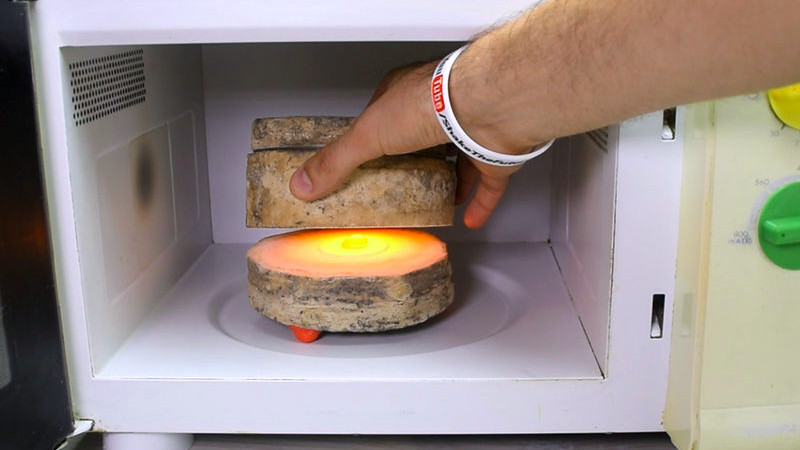We are normally told that microwave ovens are strictly for food only, and that anything else will cause all sorts of bad things to come our way. There can be few readers who haven’t at some time seen the shower of sparks when an inadvertent metallic object finds its way onto the turntable.
A particularly useful non-food application for a microwave oven comes in the form of the small kilns sold for glass fusing. These are ceramic cylinders coated internally with silicon carbide, and [ShakeTheFuture] shows us how to make your own.
Key to the process is ceramic fibre insulation, which is bonded both to itself and to the fused silicon carbide grit by a cured solution of waterglass, sodium silicate. The result can easily reach the required temperature for fusing glass, but also has an application in burning out surplus wax or PLA from a plaster mould. It’s particularly interesting to see the technique with the waterglass in action, and you can see a run-down of the whole thing in the video below the break.















I feel it’s important to note that just putting any given metallic object into a microwave is not guaranteed to produce sparks or arcs. Putting metal into a microwave can be done as long as you, avoid closed loops, make sure there are no sharp points, and don’t place two pieces of metal that are not electrically connected close to each other (this includes the walls of the microwave).
I have put folded up pieces of aluminum foil into the microwave many times with only one or two incidents due to sharp corners I failed to clean up. It should go without saying if you’re going to do something where you are putting metallic objects into the microwave you should stay close by while it’s in use just in case.
the arcing can be on the glass itself, because it’s electrically conductive when molten ;-)
Of course. But I was thinking of more general microwave usage where one was not melting glass. It can be quite useful sometimes when heating up foods or other things in the microwave to isolate certain parts with little foil tents, flat shields, or even foil folded into pockets.
My main reason for putting so much aluminum foil in the microwave stems from the time I was taking care of my sick dog who had kidney disease. They don’t really do dialysis for dogs, instead you give them extra fluids subcutaneously in order to keep the toxins from building up in their systems.
Subcutaneous fluids are tolerated better if they are warmed up a bit first before given (not too hot!), but unless you have a very big dog you are unlikely to use a full 1 litre IV bag each application. And while you can heat up the IV bags in the microwave, you can’t microwave the IV line set, and you can’t detach the IV lines from the bags as you would compromise the sterility of the setup.
So the solution to this problem is to build a little pocket out of aluminum foil, roll up the IV line while still connected to the bag, and place the line and drip chamber into the foil pouch. This allowed me to re-warm the bag for subsequent applications without damaging the IV line itself.
I should probably add in here for anyone else who currently is giving subcutaneous fluids to their pets, that I am NOT a medical professional and you should of course contact your vet before implementing any changes to your treatment regiment.
Of course with all this you are still battling the the inevitable, but mine lived a year longer than he wold have with out the extra fluids.
That is some quality hacking when it counts. Kudos to you.
That was slick, man. You love your dog, and that spurred your hacking genius into action.
Wouldn’t it make more sense to make the mould for the klin from cardboard? Why waste plastics? The use of a 3D printer doesn’t make sense to me because it’s more expensive and takes longer ….
Mould for kiln is NOT from plastics. He mentions removing pla from plaster mould with help of this kiln. Thats how nonghetto manufacturing is done.
3d prints are ok for prototyping, if you want to make longlasting object you use other methods of manufacturing/other types of 3d print materials, not usable with 3d printers most people associate 3d printing with. Because they are only toys used for getting “user feedback” on physical representation of finished product before manufacturing.
Or making other tooling
That’s generalising things quite a bit. For cheap printers that hobbyists might impulse buy, sure. But there is more to 3d printing than a cheapo printer from China printing with cheap materials.
Absolutely. Like any other tool, there’s the Fisher-Price version for kids, the NASA-certified version for space, and everything in between. For me, I consider my 3D printer to have been an excellent investment in a tool that I have used extensively for projects that I would not/could not have done otherwise. Projects that are definitely not “toys”. Many companies using 3D printers for “not toys”.
3d printers are a meme.
3D printers are tools. Like any other tool, they can be used appropriately and not so appropriately.
An old CD puts on a pretty good light show. Warning, it will stink up your oven.
Best done when in student digs before going out to the pub.
Stink up th oven? nah, CD are polycarbonate, made with BPA, once burning the BPA is released.
Do you still want to cook in a BPA coated oven?